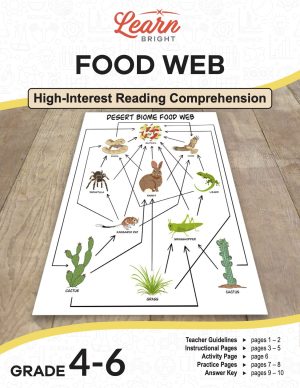Description
What our Ratio and Rate Reasoning lesson plan includes
Lesson Objectives and Overview: Ratio and Rate Reasoning introduces students to uses for ratios, proportions, and rates, and how to use each. At the end of the lesson, students will be able to use ratios, proportions, and rates to solve real-world problems. This lesson is for students in 5th grade and 6th grade.
Classroom Procedure
Every lesson plan provides you with a classroom procedure page that outlines a step-by-step guide to follow. You do not have to follow the guide exactly. The guide helps you organize the lesson and details when to hand out worksheets. It also lists information in the blue box that you might find useful. You will find the lesson objectives, state standards, and number of class sessions the lesson should take to complete in this area. In addition, it describes the supplies you will need as well as what and how you need to prepare beforehand.
Options for Lesson
Included with this lesson is an “Options for Lesson” section that lists a number of suggestions for activities to add to the lesson or substitutions for the ones already in the lesson. All of the suggestions relate to the lesson activity. One optional addition to the lesson activity is to work through one of the recipes as a whole class to demonstrate to your students how to complete the assignment. You could also have your students bring in their favorite recipe and create proportions for the entire class. Finally, you could use the recipes to create a class cookbook to give to students and their families.
Teacher Notes
The teacher notes page includes lines that you can use to add your own notes as you’re preparing for this lesson.
RATIO AND RATE REASONING LESSON PLAN CONTENT PAGES
Ratio and Rate Reasoning
The Ratio and Rate Reasoning lesson plan includes two content pages. People use ratios and rates every day, both in mathematics and in their day-to-day lives. Therefore, it’s important to understand how to use ratios and rates in real world situations. There are a number of different ways to solve ratio, rate, and proportion problems.
Example 1—Diapers
To explore this, let’s look at an example. Say you have a baby sister who uses six diapers a day. To start, you can create a table that shows the number of diapers and days. If you wanted to figure out how many diapers will be used over four days, you could add 6 to the number of diapers on day three (18) for a total of 24.
What if you wanted to know how many diapers you would need for 52 days? Adding 6 a day for 52 days would take a very long time, so you can create an equation instead. You know that the number of diapers increases by 6 each day. Therefore, the equation would be 6*(number of days) = number of diapers. Written algebraically, the equation would be 6x = y, where x represents the days and y represents the number of diapers. Using this equation, it’s easy to figure out how many diapers you need for 52 days: 6*52 = 312.
If diapers come in packs of 120, how many days would it take to use an entire pack? You can use the same equation to figure this out: 6x = 120 becomes x = 20, so it would take 20 days to use an entire pack of diapers.
Another way to solve these problems is to use a line graph. To do this, you use the x and y values to create coordinates that you then plot on a graph. Next, connect the points to make a line. If you extend the line, you can see how many diapers would be used on different days.
Example 2—Chicken Fingers
Let’s take a look at another example. Say it takes 48 chicken fingers to feed a class of 20 students. How many chicken fingers would you need to feed 30 students?
To solve this problem, you could set up a proportion. To do this, you need to identify the two items to compare (students and chicken fingers). Next, just put the numbers in the right spots. It doesn’t matter which item you put in the numerator or denominator—you’ll get the same answer either way.
For this problem, the proportion is students/chicken fingers = 20/48. Next, you add in the second piece of information (the question being asked): students/chicken fingers = 20/48 = 30/?. Finally, you use cross products to solve for the missing value: 30*48 = 1,440/20 = 72. To feed 30 students, you need 72 chicken fingers.
You can also solve this kind of problem by using a table and filling in the information that you have. Using this method to find the number of chicken fingers needed for 30 students, you could simply double the number of chicken fingers needed for 20 to find the number needed for 40 students (48*2 = 96). Next, take the midpoint of 96 by subtracting and dividing by 2: (96 – 48 = 48) and (48 ÷ 2 = 24). Finally, add 48 and 24 to get the number of chicken fingers needed for 30 students: 48 + 24 = 72.
RATIO AND RATE REASONING LESSON PLAN WORKSHEETS
The Ratio and Rate Reasoning lesson plan includes four worksheets: an activity worksheet, a practice worksheet, a homework assignment, and a quiz. You can refer to the guide on the classroom procedure page to determine when to hand out each worksheet.
COOKIE MATH ACTIVITY WORKSHEET
Students can work either alone or in pairs to complete the lesson activity. For the activity, students will choose one of the cookie recipes listed on the worksheet and calculate the amount of each ingredient needed to make different numbers of cookies (one dozen, three cookies, four cookies, 36 cookies, and 48 cookies). They will also answer a few questions about how they calculated the amount of each ingredient.
REAL WORLD PROBLEMS PRACTICE WORKSHEET
For the practice worksheet, students will solve four real world problems by setting up a proportion or table and drawing a graph.
RATIO AND RATE REASONING HOMEWORK ASSIGNMENT
The homework assignment asks students to solve five real world problems using the method that works best for them.
QUIZ
This lesson also includes a quiz that you can use to test students’ understanding of the lesson material. For the quiz, students will solve two real world problems by setting up a proportion or table and drawing a graph.
Worksheet Answer Keys
This lesson plan includes answer keys for the activity worksheet, the practice worksheet, the homework assignment, and the quiz. If you choose to administer the lesson pages to your students via PDF, you will need to save a new file that omits these pages. Otherwise, you can simply print out the applicable pages and keep these as reference for yourself when grading assignments.









